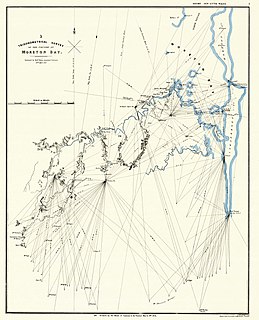
Stradbroke Island, also known as Minjerribah, was a large sand island that formed much of the eastern side of Moreton Bay near Brisbane, Queensland until the late 19th century. Today the island is split into two islands: North Stradbroke Island and South Stradbroke Island, separated by the Jumpinpin Channel.

The South Stradbroke Island, colloquially South Straddie, is an island that lies within Moreton Bay in the Australian state of Queensland, south of Brisbane and forms the northern end of Gold Coast. The island is a locality within the City of Gold Coast. In the 2016 census, South Stradbroke had a population of 41 people.

North Stradbroke Island, colloquially Straddie or North Straddie, is an island that lies within Moreton Bay in the Australian state of Queensland, 30 kilometres (19 mi) southeast of the centre of Brisbane. Originally there was only one Stradbroke Island but in 1896 it split into North Stradbroke Island and South Stradbroke Island separated by the Jumpinpin Channel. The Quandamooka people are the traditional owners of North Stradbroke island.
Amity is a rural town and locality in the City of Redland, Queensland, Australia. In the 2016 census, the locality of Amity had a population of 387 people.

Amblypsilopus is a genus of flies in the family Dolichopodidae. It is a large genus, with about 350 species recorded. However, it is possibly polyphyletic.
Antyx is a genus of flies in the family Dolichopodidae from the Australasian realm. The genus was originally placed in the subfamily Sympycninae, but it was later found to be closer to the Neurigoninae and was placed as incertae sedis within the family. In the World Catalog of Dolichopodidae by Yang et al. (2006), the new subfamily Antyxinae was proposed, in which Antyx is the only genus. However, the validity of this new subfamily was later criticized by Sinclair et al. (2008). According to them, the subfamily's erection by Yang et al. (2006) was not justified by their phylogenetic analysis, and the genus would have been better placed as incertae sedis until a later phylogenetic study determines its placement.

Asyndetus is a genus of flies in the family Dolichopodidae. There are more than 100 species described for the genus, distributed worldwide.
Ceratopos is a genus of flies in the family Dolichopodidae, known from Algeria and Portugal. It contains only one species, Ceratopos seguyi. It is closely related to Syntormon, and is considered a junior synonym of it according to Evenhuis & Bickel (2022).
Kowmungia is a genus of flies in the family Dolichopodidae. It is known from Australia.

Medetera is a large genus of flies in the family Dolichopodidae.
Mesorhaga is a genus of flies in the family Dolichopodidae.

Paraclius is a genus of flies in the family Dolichopodidae.
Phrudoneura is a genus of fly in the family Dolichopodidae from the Australasian realm. It was originally created as a subgenus of Sympycnus. It is currently regarded as incertae sedis within the family by Daniel J. Bickel (2013), though is possibly close to Sympycninae.

Sciapus is a genus of long-legged flies in the family Dolichopodidae. There are about 82 described species in Sciapus.
Jandai is an extinct Australian Aboriginal language of the Quandamooka people who live around the Moreton Bay region of Queensland. Other names and spellings are Coobenpil; Djandai; Djendewal; Dsandai; Goenpul; Janday; Jendairwal; Jundai; Koenpel; Noogoon; Tchandi. Traditionally spoken by members of the Goenpul people, it has close affinities with Nunukul language and Gowar language. Today now only few members still speak it.

The Quandamooka people are Aboriginal Australians who live around Moreton Bay in Southeastern Queensland. They are composed of three distinct tribes, the Nunukul, the Goenpul and the Ngugi, and they live primarily on Moreton and North Stradbroke Islands, that form the eastern side of the bay. Many of them were pushed out of their lands when the English colonial government established a penal colony near there in 1824. Each group has its own language. A number of local food sources are utilised by the tribes.

Hydrophorinae is a subfamily of flies in the family Dolichopodidae. According to Germann et al. (2011), the subfamily is polyphyletic.
Cryptophleps is a genus of flies in the family Dolichopodidae.

Peloropeodinae is a subfamily of flies in the family Dolichopodidae. According to Germann et al. (2011), the subfamily is polyphyletic.










